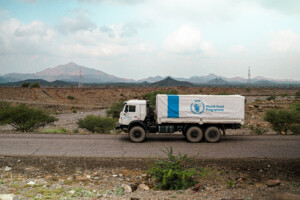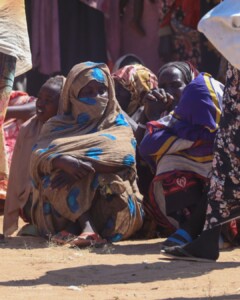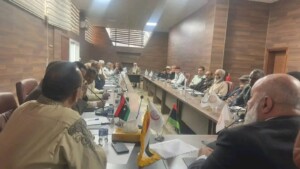Sudan OCHA bulletin 26: WFP expands the delivery of food through Sudan to people in need in South Sudan
The World Food Programme (WFP) has successfully sent the first aid convoy to deliver food assistance from Sudan to the South Sudanese city of Aweil in Bahr El-Ghazal, the organization said in a press release on 29 November. In 2018, WFP plans to send 30,000 metric tons (MT) of life-saving assistance down the new route to feed about 1.7 million people in South Sudan for 10 months.
The World Food Programme (WFP) has successfully sent the first aid convoy to deliver food assistance from Sudan to the South Sudanese city of Aweil in Bahr El-Ghazal, the organization said in a press release on 29 November. In 2018, WFP plans to send 30,000 metric tons (MT) of life-saving assistance down the new route to feed about 1.7 million people in South Sudan for 10 months.
The UN Office for the Coordination of Humanitarian Affairs (OCHA) reports in its latest biweekly humanitarian bulletin that it took five days for the 19 WFP-contracted truck convoy, carrying 500 MT of sorghum, to travel 830km from Sudan’s El Obeid town (North Kordofan State) to Aweil in South Sudan. The 500 MT of sorghum is enough to meet the emergency food needs of 30,000 people for one month.
WFP is now able to reach three locations in South Sudan by road from Sudan, including Renk, Bentiu and now Aweil. This enables WFP to deliver life-saving assistance more swiftly and efficiently and makes it easier to pre-position food before the rainy season, which cuts road access to many communities.
In 2014, WFP and the governments of Sudan and South Sudan signed a memorandum of understanding (MoU), which designates WFP as the sole agency responsible for the transportation of humanitarian cargo from Sudan to South Sudan. This 2014 MoU reopened the humanitarian corridor for the first time since the two countries separated in 2011.
So far in 2017, WFP Sudan has delivered about 42,600 MT of food – out of 97,260 MT over the past three years – to over 1.2 million conflicted-affected people facing acute hunger in South Sudan. The current MoU has been extended until June 2018.
World Malaria Report 2017: continued vigilance needed in Sudan despite downward trend

A new report by the World Health Organization (WHO) shows that, reported malaria cases in Sudan have fallen since a spike of 1.2 million in 2014 to nearly 900,000 cases this year. However, additional estimates paint a different picture, which indicates that caution and continued vigilance remain necessary.
First, both the fluctuating longer-term trend (from 1.5 million in 2010, to 964,000 in 2012 and back up to 1.2 million in 2014) and the growing at-risk population (from over 32 million in 2010 to almost 37 million in 2016) indicate that malaria continues to be an area of significant concern in Sudan.
Second, due to imperfections in surveillance data, reported figures only show a partial picture. WHO estimates show a malaria incidence of 35.2 per 1,000 people at risk in 2010, which decreased to 33.7 in 2012, and then increased again to 35.3 in 2016. This fluctuating pattern shows some setbacks, or at least stalling of the progress. To prevent setbacks and ensure sustained progress in Sudan, there is a need for increased response measures and investments, particularly from national resources, WHO said.
On a global scale, the new report finds that after an unprecedented period of success in malaria control, progress has now stalled, and that the world is not on track to achieve the 2020 targets of the WHO Global Technical Strategy for Malaria – calling for a 40 per cent reduction in case incidence and mortality.
Factors contributing to this stalling of progress include a lack of funding growth. Available financial resources for the global malaria response have plateaued since 2010, reaching US$ 2.7 billion in 2016 (less than half of the 2020 funding target). With current levels of funding and current tools, the limits of what can be achieved become visible, the WHO report stated.
The report signals a clear need for greater investment in malaria control – particularly at the domestic level. Gaps in the coverage of existing tools that prevent, diagnose and treat malaria must be urgently closed. The need for robust investment in the research and development is also high.
Additionally, at the global level there is the need for increasing efforts and investment and capacity-building; strengthening surveillance; and providing universal health coverage including malaria prevention, diagnosis and treatment for all at risk populations, particularly marginalized people including IDPs and refugees.
Progress in combating malaria, both globally and in Sudan, can only be achieved through concerted action by all stakeholders, with countries in the driver’s seat. The targets of WHO’s global malaria strategy are not out of reach, but they do need urgent action.
FEWS NET: Food security improves in Sudan except in parts of Kassala and North Darfur
The main season harvests, which started in October in many parts of Sudan, are contributing to the improvement of food security to Minimal – equivalent to the Integrated Food Security Classification (IPC) Phase 1 – or Stressed (IPC Phase 2) levels throughout most of the country, according to the latest Key Message update from FEWS NET. FEWS NET provides projected outlooks and other updates on food security across Sudan based on analysis of current national agricultural and food security conditions, climatic evidence and other factors affecting food security from various sources, including Government of Sudan institutions and other partners.
However, conflict-affected areas controlled by the Sudan People’s Liberation Movement – North (SPLM-N) in South Kordofan and conflict-affected areas in Jebel Marra in Darfur will remain in Crisis (IPC Phase 3) levels of food security, FEWS NET reported.
Furthermore, areas of Kassala and North Darfur, where seasonal progress was particularly poor, are also facing Crisis (IPC Phase 3) outcomes.
In South Kordofan, a rapid inter-agency needs assessment carried out in October in areas near Dilling town (Alfarshaya, Eltukma, Elnila and Altumat) identified approximately 10,000 internally displaced persons (IDPs) living in protracted displacement. Their main sources of food and income are subsistence farming and paid labour. However, they have limited access to cultivable land, due to insecurity, and lack cash to lease land from the host community, affecting their food security.
Food prices start to decline in markets with harvest underway – FEWS NET
With harvests underway from October in many grain producing areas in Sudan, nominal retail food prices have started to decline marginally in most regional markets, according to the November 2017 issue of the Sudan Price Bulletin by FEWS NET.
For instance, prices for sorghum (feterita) have declined in October compared to September in El Geneina (the sharpest drop of 35 per cent on a month-to-month basis), Nyala, Kadugli (about 25 per cent reduction), El Obeid and Gedaref.
Sorghum prices remained similar to September prices in Ed Damazine, El Fasher, Dongola and Port Sudan.
As for millet, price reductions have been observed in El Fasher, El Geneina, Nyala and other major markets.
Meanwhile, wheat prices have declined only in El Obeid, otherwise they stayed constant or increased compared to September. This can be attributed to the fact that winter wheat harvest is yet to start, especially in northern parts of Sudan.
According to FEWS NET, sorghum, millet, and wheat are the most important food commodities in northern Sudan. Sorghum is the staple food for the majority of poor households in central and eastern regions of Sudan, while millet is the main staple food for majority of households in Darfur and some parts of Kordofan in western Sudan. Wheat most often used as a substitute all over northern Sudan, but it is a staple food for northern states.
EPI routine vaccination campaign carried out in the Jebel Marra area
An expanded program on immunization (EPI) acceleration campaign was carried out in South Darfur’s East Jebel Mara locality in October. During the campaign, almost 4,000 children under the age of one from 128 villages in the locality have been immunised with different routine vaccines. However, there were children in 32 villages in the area who were not reached because of security concerns. This EPI campaign is regarded is a major success in 2017 as East Jebel Marra locality has lacked health services and children could not be vaccinated for many years due to the conflict. Two more rounds of vaccination activities are planned in the upcoming weeks, according to aid agencies.
HAC requests a joint needs assessment in Rokoro locality, Central Darfur
Also in the Jebel Marra area, the government’s Humanitarian Aid Commission (HAC) has requested humanitarian partners in Central Darfur State to conduct a joint in-depth needs assessment in Rokoro locality to identify needs and gaps in the ongoing humanitarian response. The planned mission (by road) is expected to take place in early January 2018 due to the unavailability of armed escorts from the United Nations-African Union Mission in Darfur (UNAMID), as troop rotations are planned from 4 December.
UN Security Council Working Group on Children and Armed Conflict visits Sudan
The UN Security Council Working Group on Children and Armed Conflict visited Sudan from 26 to 29 November to assess the issue of children and armed conflict in Sudan.
The delegation met senior government and UN officials, the UN Country Team and NGOs working in the protection sector. They also met with women, children and community members in North Darfur’s Sortony area, where they had the chance to listen to the concerns of the community first-hand and understand the immense challenges displaced persons, particularly children, face in Sudan. The mission also met with children formerly associated with armed groups and discussed their hopes and concerns.
In a statement issued on 30 November, the delegation stated that it was encouraged by the strong commitment of the Government of Sudan and commended the measures taken to ensure that no children are recruited within the armed forces, and that access is provided to the UN for monitoring and verification, including to military bases, training facilities and recruitment units. The delegation further encouraged the continued implementation of the Action Plan to Protect Children from Violations in Armed Conflict— signed on 27 March 2016—and to institutionalise the gains made so far. This includes, adopting clear standard operating procedures for the release and handover of children associated with armed groups to civilian child protection actors; strengthening age verification mechanisms; establishing a complaint mechanism; and designing a national awareness campaign on child recruitment.
The delegation stressed that the Sudanese Armed Forces (SAF) should continue to pave the way for all security forces to prevent the recruitment and use of children among its ranks. This can be done by supporting the establishment of Child Protection Units in all security forces as well as institutionalizing command orders and trainings on Child Protection for these forces.
The delegation also noted the crucial role played by Family and Child Protection Units in conflict-affected states as part of a wider effort to hold perpetrators accountable for child rights violations and assistance to child victims. Encouraged by the improved humanitarian access, the delegation urged the Government of Sudan to continue providing humanitarian access for the UN and partners to all children affected by armed conflict.
The Security Council Working Group on Children and Armed conflict was established pursuant to Security Council resolution 1612 (2005). Its mandate is to review the reports of the UN Secretary-General and other pertinent information concerning grave violations against children affected by armed conflict around the world, and to make recommendations to Governments and other parties to armed conflict with regards to such violations.
Read the complete report here (PDF












 and then
and then